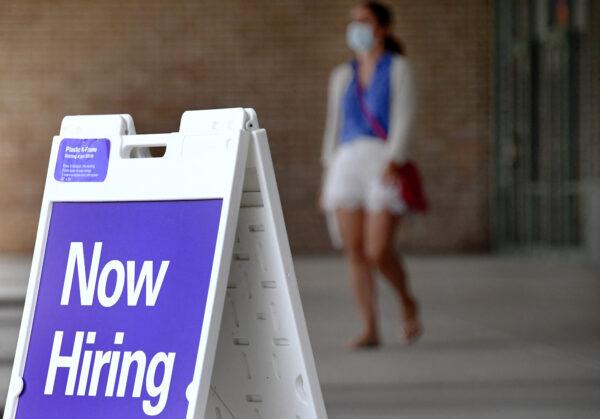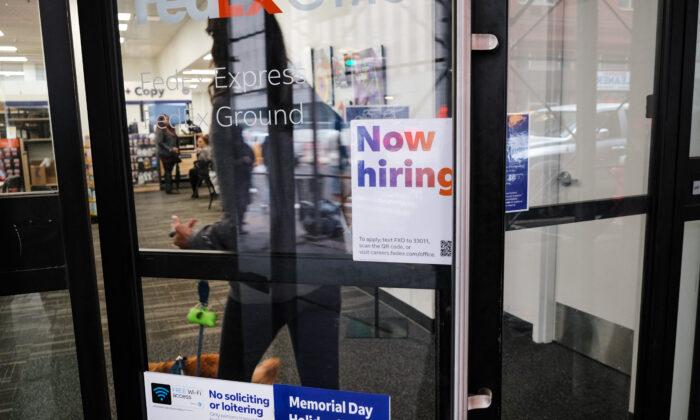Employment gains were revised down for February by 78,000 to 248,000 and changed downward for March by 71,000 to 165,000.
The unemployment rate edged lower to 3.4 percent, down from 3.5 percent and below economists’ expectations of 3.6 percent.
Average hourly earnings rose to 4.4 percent year-over-year, slightly higher than 4.3 percent in March. On a monthly basis, average hourly earnings climbed 0.5 percent, up from 0.3 percent.
Average weekly hours were unchanged at 34.4. The labor force participation rate was also flat, at 62.6 percent.
Employment gains were broad-based, led by professional and business services (43,000), health care (40,000), leisure and hospitality (31,000), financial activities (23,000), and government (23,000).
“Employment was little changed over the month in other major industries, including construction, manufacturing, wholesale trade, retail trade, transportation and warehousing, information, and other services,” the BLS reported.
“Though jobs growth has already started to slow, we haven’t seen job losses yet,” Winograd said. “As we move into the second half of the year, we will see some negative months, but the data suggests we’re still a long way from that.

The number of people working two or more jobs remained elevated at 7.707 million. The number of individuals employed part-time for economic reasons was little changed at 3.9 million. The number of people not in the labor force but who want a job surged by 346,000 to 5.3 million.
The revisions signal that the national labor market might not be as strong as what has been reported, according to EJ Antoni, research fellow of regional economics at the Center for Data Analysis at The Heritage Foundation.
“These revisions are turning beats into misses, revealing that payroll gains have been weaker than expected, not stronger. The weakness in the labor market is expressed not only in the slowdown of hiring but also real earnings growth, which has been negative,” he told The Epoch Times.
Real wage growth (inflation-adjusted) was also likely negative in April, Antoni said.
“That means people got paid more but could afford less, which does not sound like a strong labor market, but a desperate one,” he noted.
Still, after the jobs data, financial markets were hovering in positive territory in pre-market trading, with the leading benchmark indexes up about 0.4 percent.
The U.S. Treasury market was mostly positive across the board, with the benchmark 10-year yield adding nearly 10 basis points to about 3.45 percent.
The U.S. Dollar Index, a measurement of the greenback against a basket of currencies, rose by 0.3 percent to above 101.70.
“April delivered another month of jobs results that beat economists’ expectations as the labor market remains resilient,” said Cody Harker, head of data and insights at recruitment marketing firm Bayard Advertising. “Despite a general cooling trend, the market pushes forward once again, driven by solid momentum in COVID-sensitive verticals and continued consumer spending on services.”
So, what does this mean for the Federal Reserve?
Strong wage growth and lower joblessness offer the central bank more flexibility in its tightening cycle, market experts say.
“It has been the one major sticking point in the Fed’s inflationary battle as unemployment remains at historical lows. While it tends to be a lagging inflationary signal, it is important for the Fed to see the labor market cool—now more than ever,” Jay Woods, chief global strategist at Freedom Capital Markets, said.
Despite a resilient NFP report, Bryce Doty, senior vice president and senior portfolio manager at Sit Investment Associates, said he doesn’t think this report signals an economy “in great shape.”
“People are going back to work because they have burned through their savings,” he said. “Companies may finally be able to fill positions that have been open for a long time. This report should not be mistaken for an economy in great shape given the recent string of poor economic data and looming credit crunch.”
Mixed Data
After two strong job reports in January and February, conditions had ostensibly cooled. There have been more layoffs, a decline in job openings and quits, slowing wage growth, and tighter credit conditions, forcing employers to prioritize.This past week, the employment data offered different indicators.
As credit conditions continue to tighten in the fallout of the Silicon Valley Bank, Signature Bank, and First Republic failures, the U.S. labor market might still be absorbing economic conditions.




